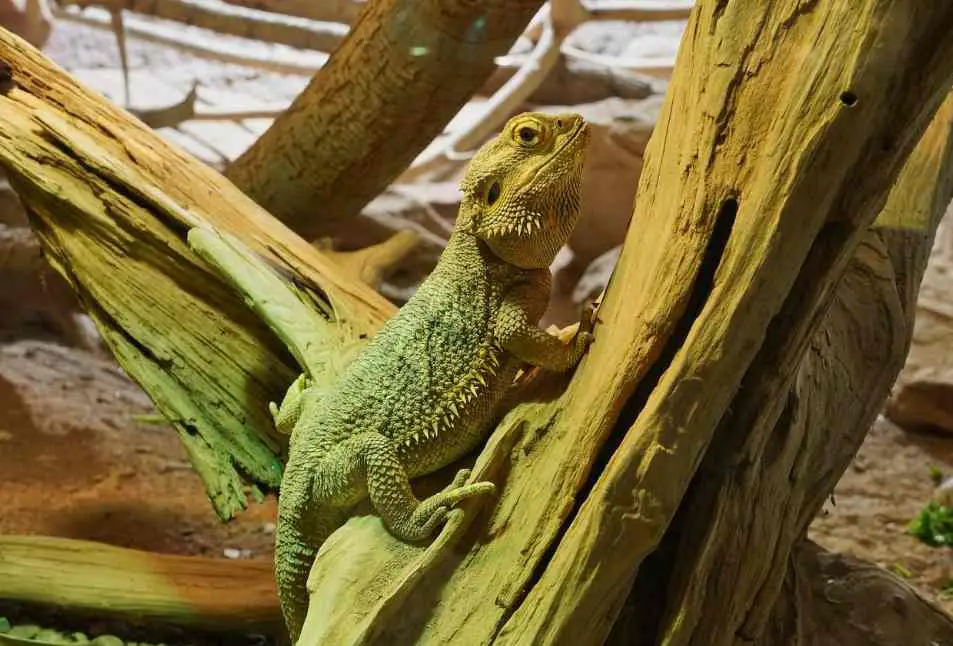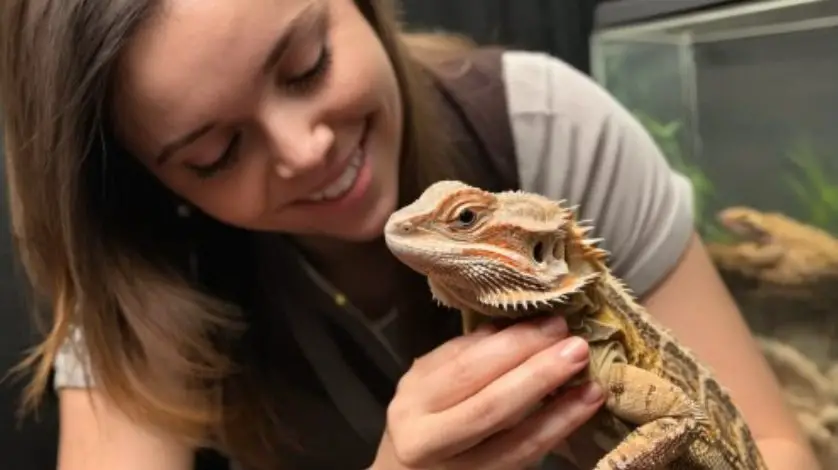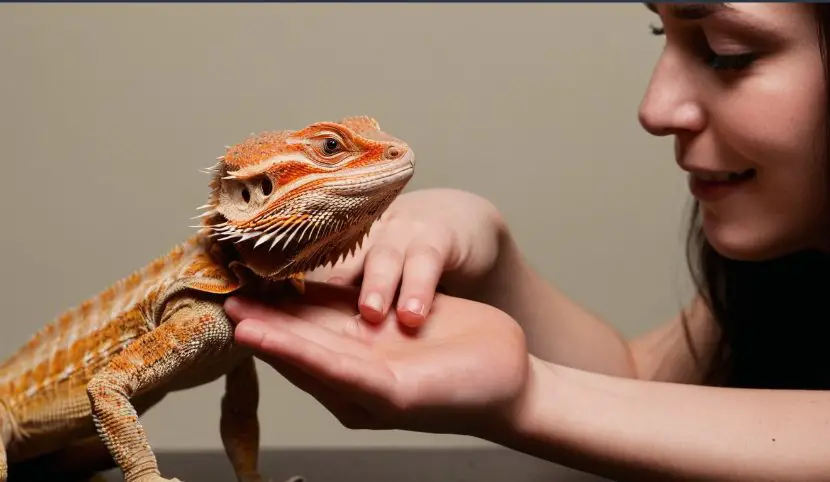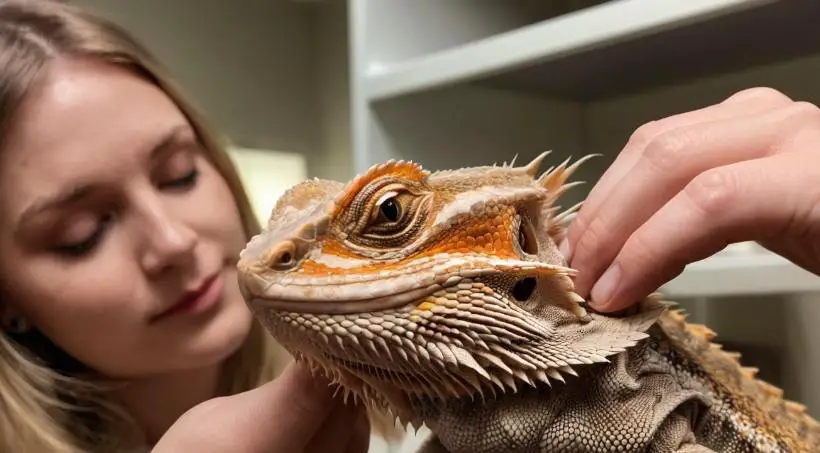16 Most Important Bearded Dragon Care Tips

Are you ready to dive into the captivating world of Bearded Dragon care?
Whether you’re a seasoned owner or thinking about adding one of these scaly wonders to your family, this blog post is your ultimate guide.
So, grab a cup of coffee, sit back, and let’s embark on an exciting journey of Bearded Dragon companionship together!
Bearded Dragon Care
Bearded dragons make fascinating pets, but they require proper care to thrive.
Firstly, ensure they have a spacious enclosure with appropriate lighting, temperature, and humidity levels.
Secondly, provide a varied diet consisting of insects, vegetables, and occasional fruits.
Additionally, offer regular baths to keep them hydrated and aid in shedding.
Lastly, spend quality time with your bearded dragon, handling and interacting with them to promote socialization and mental stimulation.
Remember, attentive care and a suitable environment are key to ensuring a healthy and happy bearded dragon.
Let’s break it down further…
Here are some important bearded dragon care tips:
1. Replicate and setup bearded dragon natural habitat
Replicating and setting up a bearded dragon’s natural habitat is crucial for their well-being.
These reptiles originate from the arid regions of Australia, so it’s important to recreate a similar environment for them.
Start by providing a spacious enclosure with a variety of hiding spots, basking areas, and climbing structures.
You can use rocks, branches, and even artificial plants to create a stimulating and natural-looking habitat.
Don’t forget to include a shallow water dish for drinking and bathing.
2. Install recommended full-spectrum UVB lighting
Installing recommended full-spectrum UVB lighting is essential for a bearded dragon’s health.
These lizards require UVB light to properly metabolize calcium and prevent metabolic bone disease.
Make sure to choose a high-quality UVB bulb specifically designed for reptiles and follow the manufacturer’s instructions for placement and duration of exposure.
Remember to replace the bulb every six to twelve months, as the UVB output diminishes over time.
3. Use reptile-safe sand and a well-ventilated vivarium
When it comes to substrate, it’s best to use reptile-safe sand or a well-ventilated vivarium.
Avoid using loose substrates like loose sand or wood chips, as bearded dragons can accidentally ingest them and develop impaction, which is a serious health concern.
Instead, opt for reptile-safe sand that is fine-grained and doesn’t clump together.
Another option is to use non-adhesive shelf liner or reptile carpet as a substrate.
These alternatives are easy to clean and reduce the risk of impaction.
4. Provide ideal humidity range for a bearded dragon’s habitat
Maintaining the ideal humidity range for a bearded dragon’s habitat is crucial for their overall health.
Bearded dragons require a relatively low humidity environment, typically between 30% and 40%.
To achieve this, ensure proper ventilation in the enclosure by using a screen top or vents.
You can also use a hygrometer to monitor the humidity levels regularly. If the humidity exceeds the recommended range, you can use a dehumidifier or increase airflow in the enclosure.
On the other hand, if the humidity is too low, you can mist the enclosure lightly or provide a shallow water dish to increase the moisture.
5. Offer a balanced diet consisting of insects and plant matter

Feeding your bearded dragon a balanced diet is crucial for its overall health and well-being.
These little reptiles are omnivores, which means they require a combination of insects and plant matter in their diet.
You can offer them a variety of insects such as crickets, mealworms, and dubia roaches. These can be easily found at pet stores or online.
It’s important to provide gut-loaded insects, which means feeding them nutritious food before offering them to your bearded dragon.
This ensures that your dragon gets the necessary nutrients.
In addition to insects, you should also include plant matter in their diet.
Dark leafy greens like collard greens, mustard greens, and dandelion greens are excellent choices.
You can also offer other vegetables like squash, bell peppers, and carrots, but avoid feeding them high-oxalate vegetables like spinach or kale too frequently.
Remember to chop the greens and veggies into small, bite-sized pieces to make it easier for your bearded dragon to eat.
Providing a variety of food items will help prevent nutritional deficiencies and keep your dragon happy and healthy.
Learn more about what bearded dragons can eat.
6. Offer a basking spot and ensure adequate heating sources
Bearded dragons are ectothermic creatures, which means they rely on external heat sources to regulate their body temperature.
To create a comfortable environment for your dragon, you need to provide a basking spot with a heat source, such as a heat lamp or a ceramic heat emitter.
The basking spot should be warm, around 95-105°F (35-40°C), to allow your bearded dragon to thermoregulate.
You can use a reptile thermometer to monitor the temperature accurately. Place the heat source at one end of the enclosure, creating a temperature gradient.
This allows your dragon to move between the warmer basking spot and cooler areas as per its preference.
It’s also essential to provide a UVB light source. Bearded dragons require UVB radiation to synthesize vitamin D3, which is crucial for calcium absorption and preventing metabolic bone disease.
UVB bulbs specifically designed for reptiles are available in pet stores.
Make sure to follow the manufacturer’s instructions regarding the distance between the bulb and your dragon’s basking spot.
7. Provide a shallow dish of fresh, clean water for drinking
Hydration is essential for your bearded dragon’s health. Always provide a shallow dish of fresh, clean water within the enclosure for drinking.
Choose a sturdy dish that is shallow enough for your dragon to access easily.
Bearded dragons may also enjoy soaking in the water occasionally, so make sure the dish is large enough for them to do so comfortably.
It’s important to change the water daily to ensure cleanliness and prevent bacterial growth.
Some bearded dragons may not drink water directly but obtain moisture from their food.
However, having a water dish available is still important as it provides an option for hydration.
8. Establish a feeding schedule appropriate for your bearded dragon’s age
Feeding your bearded dragon on a regular schedule is beneficial for its digestive health and overall routine. The feeding frequency varies depending on your dragon’s age.
For baby bearded dragons (up to 3 months old), feed them 2-3 times a day, offering a combination of insects and finely chopped greens.
As they grow, you can gradually reduce the number of feedings and increase the amount of plant matter.
Juvenile bearded dragons (3-12 months old) can be fed twice a day, with a diet consisting of about 80% insects and 20% plant matter.
Adult bearded dragons (over 12 months old) can be fed once a day. Their diet should consist of about 80% plant matter and 20% insects.
It’s crucial to monitor your bearded dragon’s weight and adjust the feeding schedule accordingly.
Always provide fresh food during each feeding and remove any uneaten food after a few hours to maintain cleanliness.
9. Clean the enclosure regularly to maintain a hygienic environment
Keeping your bearded dragon’s enclosure clean is essential for their well-being.
Regular cleaning helps maintain a hygienic environment and prevent the buildup of bacteria.
Start by removing any uneaten food, feces, and shedding skin daily. This will prevent odors and potential health issues. Also, spot-clean any soiled areas promptly.
On a weekly basis, perform a deep clean. Remove your bearded dragon from the enclosure and transfer them to a temporary habitat.
Remove all the accessories, such as rocks, branches, and hides, and clean them thoroughly with warm water and a reptile-safe disinfectant.
Wipe down the enclosure walls, substrate, and any other surfaces. Rinse everything thoroughly to remove any traces of cleaning agents, as they can be harmful to your pet.
Finally, dry everything completely before reintroducing your bearded dragon to its clean and fresh home.
10. Monitor growth and adjust enclosure size
As your bearded dragon grows, you’ll need to ensure their enclosure provides adequate space.
A cramped environment can lead to stress and stunted growth. When they’re young, a 20-gallon enclosure is usually sufficient.
However, as they mature, you’ll need to consider upgrading to a larger enclosure.
A general guideline is to provide at least 40 gallons for adult bearded dragons.
This will give them enough space to move around comfortably. Additionally, make sure the enclosure has proper ventilation to maintain good air quality.
Consider adding climbing structures, basking spots, and hiding areas to create an enriching environment.
11. Handle with care and monitor for signs of illness

Bearded dragons can be quite docile and enjoy human interaction, but it’s important to handle them with care.
Always support their body and avoid squeezing or dropping them. Additionally, wash your hands before and after handling to prevent the transmission of any bacteria or diseases.
Regularly monitor your bearded dragon for any signs of illness. Look out for abnormal behavior, such as reduced appetite, lethargy, weight loss, or changes in bathroom habits.
Keep an eye on their skin, eyes, and mouth for any signs of infection or injury. If you notice anything concerning, consult a reptile veterinarian promptly.
Early detection and treatment can greatly improve their chances of recovery.
12. Perform weekly showers or soaks with warm water for 10–15 minutes
Bearded dragons benefit from regular hydration, and one way to provide it is through weekly showers or soaks.
Fill a shallow container with warm water that reaches up to their belly. Gently place your bearded dragon in the water and allow them to soak for 10 to 15 minutes.
This helps them stay hydrated and can aid in shedding their skin.
While your bearded dragon is in the water, supervise them closely to ensure their safety.
Some bearded dragons enjoy the water, while others may not be as fond of it.
If your pet seems stressed or uncomfortable, don’t force them to soak.
Instead, offer water through other means, such as misting their enclosure or providing a shallow water dish.
13. Providing supplements according to veterinary recommendations
When it comes to caring for your bearded dragon, ensuring they receive the right supplements is crucial.
Your veterinarian will be your best guide in determining the specific needs of your dragon.
Generally, the two key supplements you’ll focus on are calcium and vitamin D3.
Calcium is essential for bone health, while vitamin D3 aids in calcium absorption.
These supplements can be provided in powder form, which you’ll sprinkle on your dragon’s food.
Remember to follow the recommended dosage and frequency provided by your vet.
14. Providing all recommended accessories and supplies
Creating a comfortable and stimulating environment for your bearded dragon is essential.
Here’s a list of some accessories and supplies you’ll need:
a) Enclosure: Provide a spacious enclosure that mimics their natural habitat. A glass terrarium or custom-built enclosure with proper ventilation is ideal.
b) Substrate: Choose a substrate that is safe, easy to clean, and doesn’t pose a risk of impaction. Options like reptile carpet, paper towels, or ceramic tiles work well.
c) Lighting and heating: Bearded dragons require both UVB lighting and a basking spot for thermoregulation. A UVB light source will provide them with essential ultraviolet radiation. A basking light or heat lamp will help maintain the right temperature gradient.
d) Hides and climbing structures: Add a few hiding spots and branches for your dragon to climb on. They enjoy exploring and basking in elevated areas.
e) Food and water dishes: Provide shallow dishes for food and water. Ensure the dishes are easily accessible and cleaned regularly.
15. Scheduling routine veterinary check-ups
Regular veterinary check-ups are a vital aspect of your bearded dragon’s care.
These check-ups allow the vet to assess your dragon’s overall health, address any concerns, and provide preventive care.
Your vet will conduct a thorough examination, check for parasites, assess weight, and discuss any potential issues.
They may also provide additional advice on diet, enclosure setup, and general well-being.
Aim for annual check-ups, but if you notice any changes in behavior or health, don’t hesitate to schedule a visit.
16. Continuously educating yourself about bearded dragon care

As a responsible dragon owner, it’s essential to stay informed about the latest knowledge and best practices in bearded dragon care.
Keep yourself updated through reputable sources such as books, online forums, and articles from trusted reptile organizations.
Joining online communities of fellow dragon enthusiasts can also provide valuable insights and personal experiences.
By continuously educating yourself, you’ll be well-equipped to provide the best care for your scaly friend.
Remember, caring for a bearded dragon requires dedication and attention to detail.
Learn more about health issues in bearded dragons.
FAQs
What kind of habitat does a bearded dragon need?
Bearded dragons require a spacious and well-ventilated enclosure. A glass tank or terrarium with a secure lid is ideal. It should have a temperature gradient, with a warm basking spot around 95-105°F (35-40°C) and a cooler area around 75-85°F (24-29°C). A UVB light source is essential for their health.
What do bearded dragons eat?
Bearded dragons are omnivores, meaning they eat both insects and vegetables. A healthy diet consists of a variety of gut-loaded insects such as crickets and mealworms, as well as leafy greens, vegetables, and fruits. It’s important to provide proper calcium and vitamin supplementation to ensure their nutritional needs are met.
How often should I feed my bearded dragon?
Juvenile bearded dragons should be fed twice a day, with a mix of insects and vegetables. As they grow older, their feeding frequency can be reduced to once a day. It’s important to offer a variety of food to ensure a balanced diet. Always remove any uneaten food to maintain cleanliness.
How do I handle my bearded dragon?
When handling your bearded dragon, it’s crucial to approach them calmly and gently. Support their body properly, with one hand under their belly and the other supporting their back legs. Avoid grabbing or squeezing them tightly. Regular handling helps to socialize them and build trust.
Learn more about bearded dragon dislikes and likes.
How do I provide proper lighting for my bearded dragon?
Bearded dragons require both UVA and UVB lighting for their overall health. UVB lighting helps them produce vitamin D3, which enables them to absorb calcium. You can use special reptile-specific UVB bulbs that provide the necessary spectrum. Make sure to replace the bulbs regularly as they lose effectiveness over time.
How do I maintain the temperature and humidity in the enclosure?
To maintain the proper temperature gradient, you’ll need a combination of a basking light and a heat source like a ceramic heat emitter or an under-tank heater. You can monitor the temperature using a thermometer. As for humidity, bearded dragons prefer relatively low humidity levels, around 30-40%. Ensure proper ventilation to prevent excess humidity buildup.
Learn more about bearded dragon facts.
Conclusion
In conclusion, caring for a bearded dragon can be a rewarding experience. Remember to provide a warm and spacious habitat, a balanced diet of insects and vegetables, and plenty of social interaction. With proper care, your bearded dragon will thrive and become a beloved companion for years to come.
